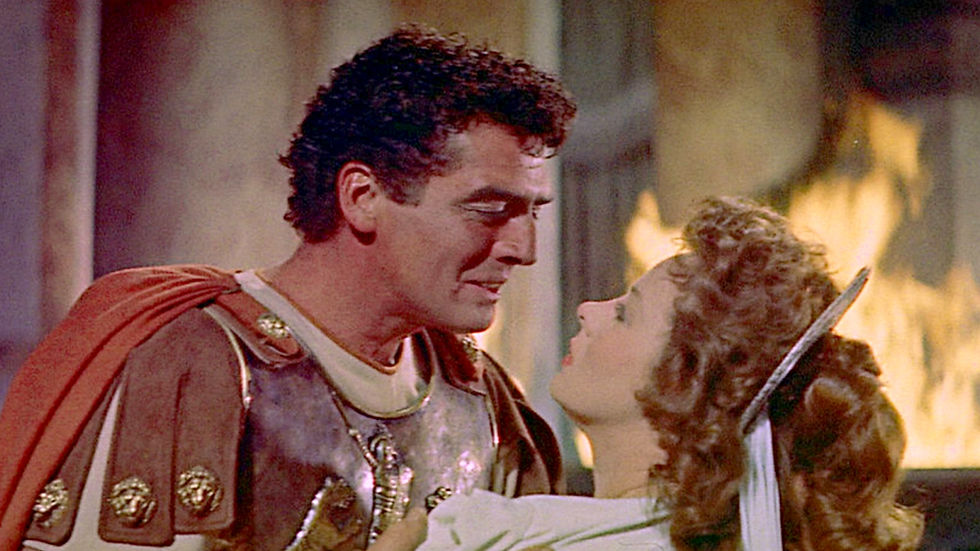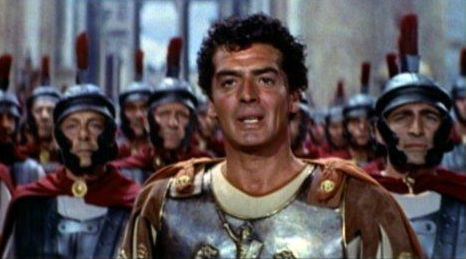Demetrius and the Gladiators (1954)
- Soames Inscker

- Apr 22
- 4 min read
Updated: Jun 7

Sword, Sandals, and Spiritual Struggle
In the 1950s, Hollywood embraced the biblical and historical epic with unmatched vigour, and Demetrius and the Gladiators (1954), directed by Delmer Daves, is a shining example of the era’s flair for grand storytelling, lavish sets, and moral complexity. As a direct sequel to The Robe (1953), the first film released in CinemaScope, this film continues to explore the early days of Christianity under Roman rule, focusing on themes of faith, identity, and redemption—with a healthy dose of gladiatorial combat and imperial intrigue.
Plot Summary
Picking up where The Robe left off, the story follows Demetrius (played by Victor Mature), a Greek slave and devout Christian who once served the centurion Marcellus Gallio. After Marcellus and his beloved Diana are martyred for their faith, Demetrius takes up the responsibility of protecting the sacred robe of Christ, now considered a holy relic.
However, Demetrius is soon captured by Roman soldiers and forced into the brutal world of gladiatorial combat under the command of Claudius (Barry Jones) and Caligula (Jay Robinson), the latter a dangerously unstable emperor obsessed with power and the divine.
As Demetrius is drawn deeper into the violence and luxury of Roman life—and into a tempestuous relationship with the seductive Messalina (Susan Hayward)—he begins to lose his spiritual compass. His internal battle between spiritual devotion and earthly temptation forms the core of the film.
Performances
Victor Mature reprises his role as Demetrius with emotional intensity and physical presence. Known more for his physique than his subtlety, Mature nonetheless imbues Demetrius with real conflict and growth. His journey from devoted believer to disillusioned killer and back again gives the film its emotional arc.
Susan Hayward as Messalina is a showstopper. She is sultry, manipulative, and fiercely intelligent—one of the film’s most dynamic characters. Hayward brings complexity to what could have been a one-note temptress, revealing both ambition and vulnerability.
Jay Robinson as Caligula delivers a performance that teeters between camp and brilliance. Returning from The Robe, Robinson exaggerates Caligula’s madness, giving us a ruler who is part clown, part monster. His scenes are compellingly chaotic and strangely magnetic.
Debra Paget as Lucia, a fellow Christian and voice of conscience, provides a gentle contrast to the imperial decadence, though her role is smaller and more symbolic.
Direction and Cinematic Style

Delmer Daves, known for his work in both westerns and dramas, keeps a tight rein on the film’s pacing and tone. Unlike the more solemn The Robe, Demetrius and the Gladiators leans into the action and spectacle, with energetic fight scenes and rich production values.
The use of CinemaScope is again a major feature. The widescreen format allows for sweeping crowd scenes, imposing Roman architecture, and vibrant gladiator battles that fill the frame. Colour cinematography, ornate costumes, and striking lighting give the film an operatic feel.
The production design is exquisite—from the polished marble halls of the Roman palace to the dusty arenas soaked in blood and sand. The film’s aesthetic strongly supports its themes of opulence versus purity, and decadence versus discipline.
Themes and Symbolism
At its heart, Demetrius and the Gladiators is about spiritual warfare—not just in the religious sense, but in the internal battle between belief and disillusionment, sacrifice and survival.
The robe of Christ serves as a physical symbol of faith and divine presence, a sacred object that stirs fear and awe. Demetrius’s journey reflects the struggle of early Christians, torn between the cruelty of the world and the teachings of Christ.
Messalina represents temptation in all its forms—power, pleasure, and passion—while Caligula is the embodiment of unrestrained ego and spiritual blindness. Their opposition to Demetrius frames a classic biblical contrast between light and darkness, earthly sin and heavenly salvation.
Reception and Legacy
While Demetrius and the Gladiators didn’t achieve the ground breaking status of The Robe, it was a commercial success and remains a favourite among fans of sword-and-sandal epics. Critics appreciated its faster pace, stronger action sequences, and Mature’s commanding presence.
The film helped solidify the popularity of the Christian-themed epic, paving the way for later works like Ben-Hur (1959), The Ten Commandments (1956), and Spartacus (1960).
It also proved that sequels could carry emotional and narrative weight—even in an age when franchises were not yet the norm.
Modern Reflection
For today’s viewers, Demetrius and the Gladiators may feel old-fashioned in its delivery, with its solemn dialogue and melodramatic acting. However, it holds up remarkably well in terms of visual spectacle and thematic ambition.
It offers a compelling character arc, moral complexity, and a stirring message about forgiveness, resilience, and rediscovered faith—all wrapped in an entertaining and visually rich package.
Final Verdict
Demetrius and the Gladiators is a compelling, visually rich sequel that expands on The Robe while offering its own emotional depth and action-packed drama. With strong performances—particularly from Victor Mature and Susan Hayward—and a thoughtful blend of religious and political themes, it's a worthy entry in the golden age of biblical epics. For fans of classic cinema, religious storytelling, or gladiator tales, this film remains a rewarding watch.






